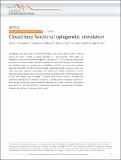| dc.contributor.author | Srinivasan, Shriya S | |
| dc.contributor.author | Maimon, Benjamin E | |
| dc.contributor.author | Diaz, Maurizio | |
| dc.contributor.author | Song, Hyungeun | |
| dc.contributor.author | Herr, Hugh M | |
| dc.date.accessioned | 2021-10-27T20:09:43Z | |
| dc.date.available | 2021-10-27T20:09:43Z | |
| dc.date.issued | 2018 | |
| dc.identifier.issn | 2041-1723 | |
| dc.identifier.uri | https://hdl.handle.net/1721.1/134892 | |
| dc.description.abstract | © 2018, The Author(s). Optogenetics has been used to orchestrate temporal- and tissue-specific control of neural tissues and offers a wealth of unique advantages for neuromuscular control. Here, we establish a closed-loop functional optogenetic stimulation (CL-FOS) system to control ankle joint position in murine models. Using the measurement of either joint angle or fascicle length as a feedback signal, we compare the controllability of CL-FOS to closed-loop functional electrical stimulation (CL-FES) and demonstrate significantly greater accuracy, lower rise times and lower overshoot percentages. We demonstrate orderly recruitment of motor units and reduced fatigue when performing cyclical movements with CL-FOS compared with CL-FES. We develop and investigate a 3-phase, photo-kinetic model to elucidate the underlying mechanisms for temporal variations in optogenetically activated neuromusculature during closed-loop control experiments. Methods and insights from this study lay the groundwork for the development of closed-loop optogenetic neuromuscular stimulation therapies and devices for peripheral limb control. | |
| dc.publisher | Springer Science and Business Media LLC | |
| dc.relation.isversionof | http://dx.doi.org/10.1038/s41467-018-07721-w | |
| dc.rights | Creative Commons Attribution 4.0 International license | |
| dc.rights.uri | https://creativecommons.org/licenses/by/4.0/ | |
| dc.source | Nature | |
| dc.title | Closed-loop functional optogenetic stimulation | |
| dc.type | Article | |
| dc.identifier.citation | Srinivasan, Shriya S., Benjamin E. Maimon, Maurizio Diaz, Hyungeun Song, and Hugh M. Herr. “Closed-Loop Functional Optogenetic Stimulation.” Nature Communications 9, no. 1 (December 2018). doi:10.1038/s41467-018-07721-w. | |
| dc.contributor.department | Massachusetts Institute of Technology. Media Laboratory | |
| dc.contributor.department | Massachusetts Institute of Technology. Center for Extreme Bionics | |
| dc.contributor.department | Harvard University--MIT Division of Health Sciences and Technology | |
| dc.contributor.department | Massachusetts Institute of Technology. Department of Electrical Engineering and Computer Science | |
| dc.relation.journal | Nature Communications | |
| dc.eprint.version | Final published version | |
| dc.type.uri | http://purl.org/eprint/type/JournalArticle | |
| eprint.status | http://purl.org/eprint/status/PeerReviewed | |
| dc.date.updated | 2019-03-01T14:07:58Z | |
| dspace.orderedauthors | Srinivasan, SS; Maimon, BE; Diaz, M; Song, H; Herr, HM | |
| dspace.embargo.terms | N | |
| dspace.date.submission | 2019-04-04T15:32:54Z | |
| mit.journal.volume | 9 | |
| mit.journal.issue | 1 | |
| mit.metadata.status | Authority Work and Publication Information Needed | |
